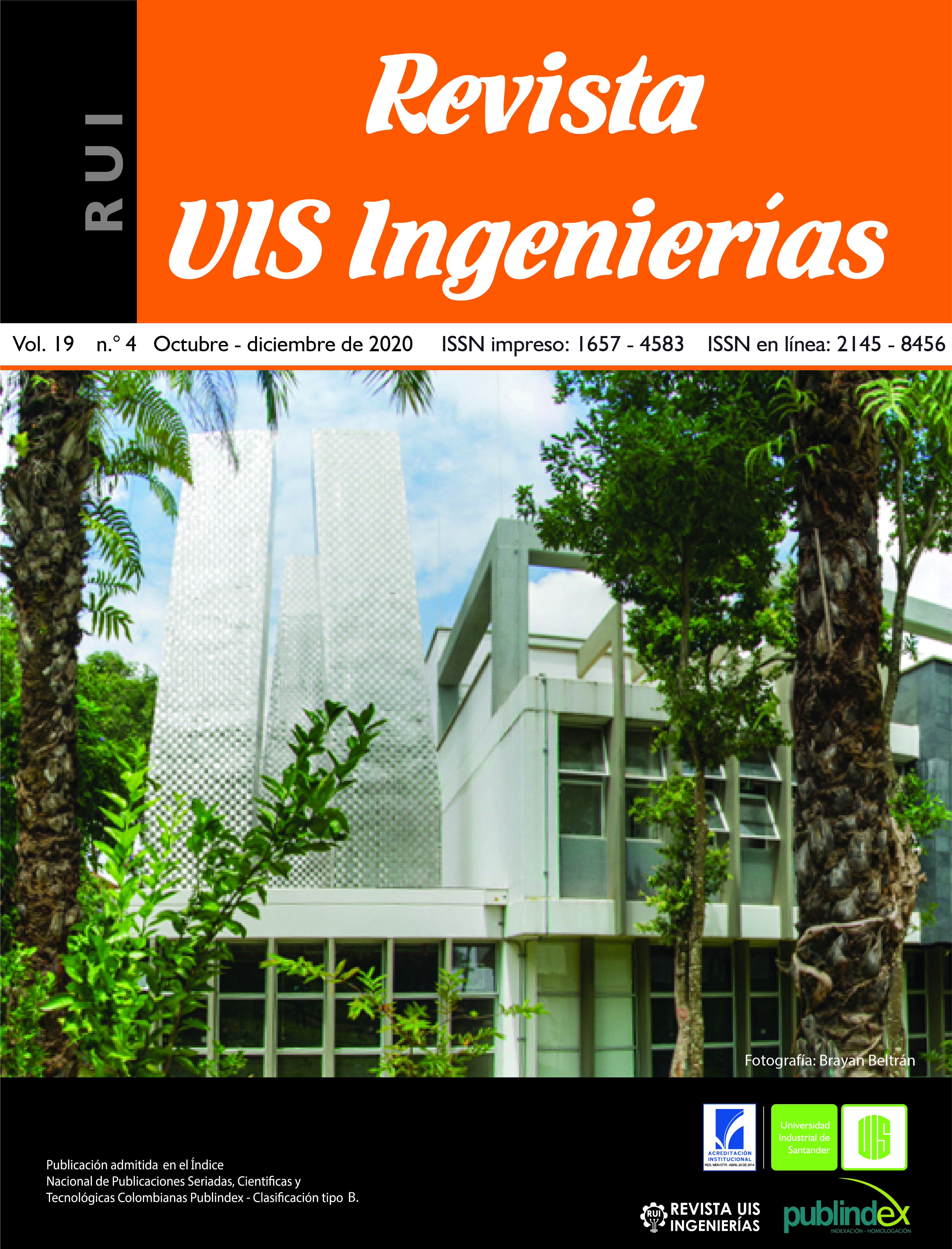Publicado 2020-06-30
Palabras clave
- geopolímeros,
- escoria blanca,
- hidróxido de sodio,
- carbonatación
Cómo citar
Derechos de autor 2020 Revista UIS Ingenierías

Esta obra está bajo una licencia internacional Creative Commons Atribución-SinDerivadas 4.0.
Resumen
En este artículo se evalúa la influencia de la andradita en la resistencia mecánica de un geopolímero sintetizado a partir de escoria blanca de horno convertidor y escoria negra de horno eléctrico. Como activadores se utilizó hidróxido de sodio 12 M y silicato de sodio 5 M. El hidróxido de sodio se mantuvo constante en 5% y en 15% en silicato de sodio. Se añadió material cerámico en proporciones del 5%,10%, 15% y 20%. El curado de la pasta se hizo a temperatura ambiente durante 24 horas. El tamaño de partículas de la escoria blanca y del material cerámico fue de 150 μm. Se utilizó XDR y MEB para analizar los posibles mecanismos de formación de la andradita y del carbonato de calcio. Se fallaron las muestras en la maquina universal de ensayos. Se determinó la influencia de los compuestos químicos formados en la resistencia a la compresión. Los resultados indican que las condiciones propuestas son adecuadas para la formación estructuras cristalinas propias de los materiales geopoliméricos.
Descargas
Referencias
[2] G. Gayathri, V. S. Ramya, T. Yasotha, M. Dheenedhayalan, “Experimental investigation on geopolymer concrete with E-waste”, International Journal of Research and Reviews in Applied Sciences and Engineering, vol. 8, no. 2, 2016.
[3] A. Hajimohammadi, T. Ngo, J. Vongsvivut, “Interfacial chemistry of a fly ash geopolymer and aggregates”, Journal of Cleaner Production, vol. 231, pp. 980-989, 2019, doi: 10.1016/j.jclepro.2019.05.249
[4] M. Ahdaya, A. Imqam, “Fly ash Class C based geopolymer for oil well cementing”, Journal of Petroleum Science and Engineering, vol. 179, pp. 750-757, 2019, doi: 10.1016/j.petrol.2019.04.106
[5] Y. Wang, J. Zhao, “Facile preparation of slag or fly ash geopolymer composite coatings with flame resistance”, Construction and Building Materials, vol. 203, pp. 655-661, 2019, doi: 10.1016/j.conbuildmat.2019.01.097
[6] P. Sarker, S. Mcbeath, “Fire endurance of steel reinforced fly ash geopolymer concrete elements”, Construction and Building Materials, vol 90, pp 91-98, 2015, doi: 10.1016/j.conbuildmat.2015.04.054
[7] M. Marcin, M. Sisol, I. Brezani, “Effect of Slag Addition on Mechanical Properties of Fly ash Based Geopolymers”, Procedia Engineering, vol. 151, pp. 191-197, 2016.
[8] F. Skvara, “Alkali activated materials or geopolymers”, Ceramics – Silikáty (2007) pp 173–177.
[9] M. Lahoti, K. Tan, E Yang, “A critical review of geopolymer properties for structural fire-resistance applications”, Construction and Building Materials, vol 221, pp 514-526, 2019, doi: 10.1016/j.conbuildmat.2019.06.076
[10] P. Sarker, S. Mcbeath, “Fire endurance of steel reinforced fly ash geopolymer concrete elements”, Construction and Building Materials, vol. 90, pp 91-98, 2015, doi: 10.1016/j.conbuildmat.2015.04.054
[11] G. Kürklü, “The effect of high temperature on the design of blast furnace slag and coarse fly ash-based geopolymer mortar”, Composites Part B: Engineering, Vol. 92, pp. 9-18, 2016.
[12] A. Villaquirán-Caicedo, D. Rodríguez, R. Mejía, “Evaluación microestructural de geopolímeros basados en metacaolín y fuentes alternativas de sílice expuestos a temperaturas altas”, Ingeniería, Investigación y Tecnología. vol. 16, pp. 113-122, 2015.
[13] M Ha , G. Le-Saout, F. Winnefeld, B. Lothenbach, “Influence of Activator Type on Hydration Kinetics, Hydrate Assemblage and Microstructural Development of Alkali Activated BlastFurnace Slags”, Cem. Concr. Res., vol 43, no 3, pp. 301-310, 2011.
[14] L. Xing, R. Feng, S. Shaoxian, A. Corona, N. Ortiz, E. Aguilar, “Effects of aggregates on the mechanical properties and microstructure of geothermal metakaolin-based geopolymers”, Results in Physics, vol 11, pp 267-273, 2018.
[15] L. Xing, R. Feng, S. Shaoxian, M. Qinyong, “Deterioration in the microstructure of metakaolin-based geopolymers in marine environment”, Journal of Materials Research and Technology, vol 8, no 3, pp 2747-2752, 2019.
[16] T. Saeki, P. Monteiro, “A model to predict the amount of calcium hydroxide in concrete containing mineral admixture”, Cement and Concrete Research, vol. 35, no. 10, pp. 1914– 1921, 2005.
[17] O. Gutiérrez, Y. Pineda, E. Vera, “Resistencia a la Carbonatación de Concretos elaborados con Ceniza Volante, Escoria de Alto Horno y Cemento Comercial”, Revista Interciencia, vol. 51, no. 4, 2015, doi: 10.3989/revmetalm.058
[18] B. Dong , Q. Qiu, J. Xiang, C. Huang, H. Sun, F. Xing, Y Liu. “Electrochemical impedance interpretation of the carbonation behavior for fly ash–slag– cement materials”, Construction and Building Materials, vol. 93, pp. 933-942, 2015.
[19] Asociación Española De Normalización Y Certificación. Productos y sistemas para la protección y reparación de estructuras de hormigón. Métodos de ensayo. Determinación de la resistencia a la carbonatación. UNE-EN 13295. Madrid: AENOR, vol. 18, 2015. Disponible en: http://www.anfapa.com/downloads/54_monografico-reparacion.pdf
[20] Réunion Internationale Des Laboratoires Et Experts Des Matériaux, Systèmes De Construction Et Ouvrages - RILEM, CPC-18 Measurement of Hardened Concrete Carbonation Depth, Materials and Structures, vol. 21, no. 6, pp 453-455, 1988. Disponible en: https://www.rilem.net/gene/main.php?base=500221&id_publication=4&id_papier=3965
[21] H. Cui, W. Tang, W. Liu, Z. Dong, Y. Xing, “Experimental study on effects of CO2 concentrations on concrete carbonation and diffusion mechanisms”, Construction and Building Materials, vol. 93, pp. 522-527, 2015.
[22] American Concrete Institute, Protection of Metals in Concrete Against Corrosion. Informe técnico ACI 222.R-01 (Reapproved 2010). Farmington Hills, MI: ACI, pp.41. 2011. Disponible en: https://www.concrete.org/store/productdetail.aspx?ItemID=22201&Format=DOWNLOAD&Language=English
[23] G. Sedmale, M. Randers, M. Rundans, V Seglins, “Application of differently treated illite and illite clay samples for the development of ceramics”, Applied Clay Science, vol. 146, pp. 397-403, 2017.
[24] P. Monich, A. Romero, D. Höllen, E. Bernardo, “Porous glass-ceramics from alkali activation and sinter-crystallization of mixtures of waste glass and residues from plasma processing of municipal solid waste”, Journal of Cleaner Production, vol. 188, pp. 871-878, 2018.
[25] J. Davitovits, “Global warming impact on the cement and aggregates industries”, Geopolymer Institute, vol. 6, no. 2, pp. 263-278, 1994.
[26] J. Davitovits, M. Davitovits, “Geopolymer: room-temperature ceramic matrix for composites”, Ceramics Engineering Science Process, vol. 9, no. 7, pp. 835-842, 1998, doi: 10.1002/9780470310496.ch34

